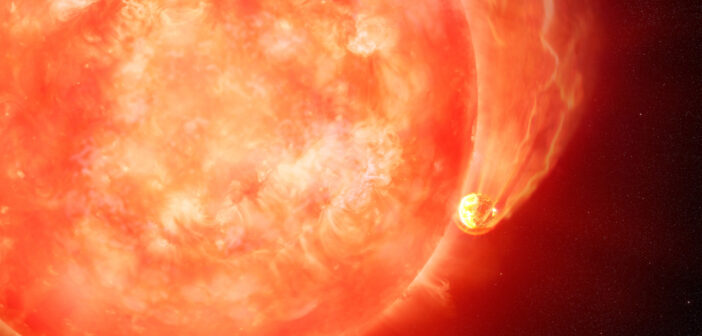New research may have revived the mystery of 8 Ursae Minoris b, a seemingly doomed exoplanet that shouldn’t exist.
The Planet That Shouldn’t Be: 8 UMi b
When first discovered, the exoplanet 8 Ursae Minoris b (8 UMi b; also called Halla) puzzled astronomers. The planet should have been engulfed by its host star as the star swelled into a red giant, but there was no question that the planet was there, resolutely tugging on its star as it completed each 93-day orbit.
Previously, researchers explained away this impossibility by suggesting that 8 UMi was once a lower-mass star with a close-in stellar companion. As 8 UMi began its expansion into a red giant, it swallowed its companion. The subsequent shakeup of 8 UMi’s interior changed its evolutionary path and halted its expansion, saving 8 UMi b from a fiery fate.
The key to testing this hypothesis is determining 8 UMi’s age: if the star is old — 9 billion years old or so — then the binary merger scenario is feasible. If the star is young, that would make a merger quite unlikely — and the mystery of 8 UMi b will live on.
Age Estimation

The position of 8 UMi on theoretical isochrones of various ages. This analysis yielded an age of 1.9 billion years for this star. [Adapted from Chen et al. 2024]
Using these data, Chen’s team estimated 8 UMi’s age with three different methods: stellar isochrones (theoretical relations between brightness and temperature for stars with different masses but the same age), kinematics, and chemical abundances. The three methods yielded age estimates in the range of 1.9–3.5 billion years — far younger than the nearly 9 billion years estimated for the binary merger scenario.

Age estimates from two chemical abundance methods. These two methods yielded age estimates of 3.3 and 3.5 billion years. Click to enlarge. [Chen et al. 2024]
A Mystery Once Again
The newly calculated age for 8 UMi would make it extremely unlikely for a merger with a binary companion to be responsible for saving 8 UMi b from engulfment. How, then, does this planet exist?
While Chen and collaborators emphasize that more work is needed to solve the mystery once and for all, one of the newly derived stellar properties could provide an explanation: Chen’s team estimated 8 UMi’s mass to be 1.7 solar masses, which is about 13% larger than previous estimates. This larger mass could mean that 8 UMi is slightly more compact than expected, and it would mean that 8 UMi b’s orbital period corresponds to a slightly larger orbital distance — just large enough, perhaps, for the planet to eke out survival on the edge of its star.
Citation
“The Kinematic and Chemical Properties of the Close-in Planet Host Star 8 UMi,” Huiling Chen et al 2024 ApJL 966 L27. doi:10.3847/2041-8213/ad3bb4
